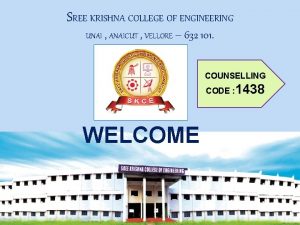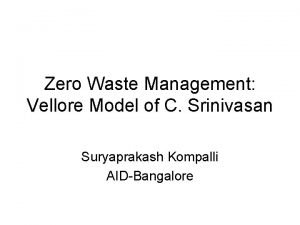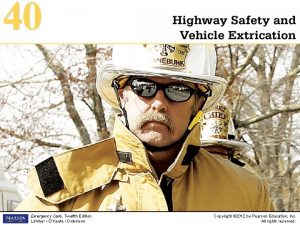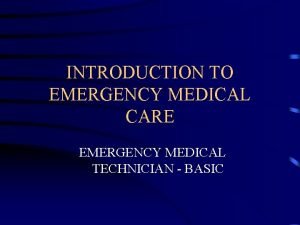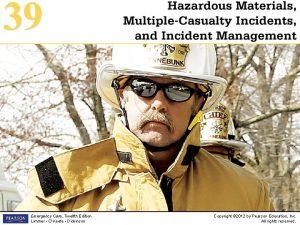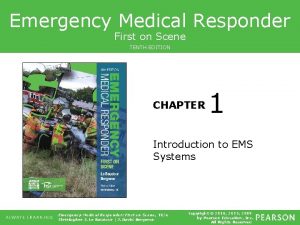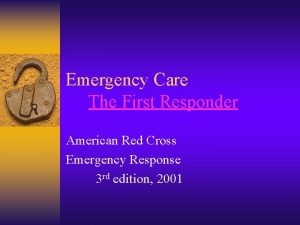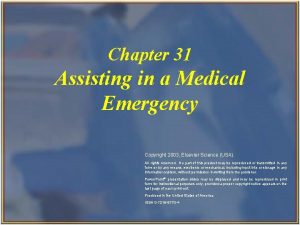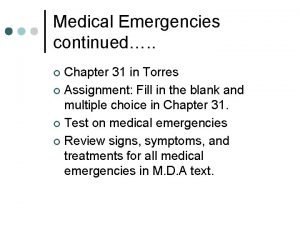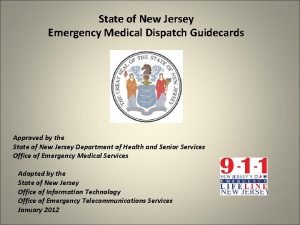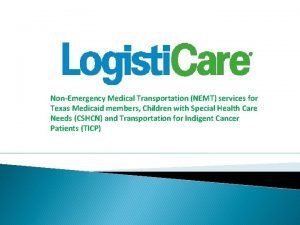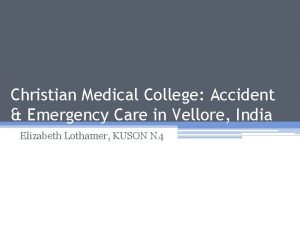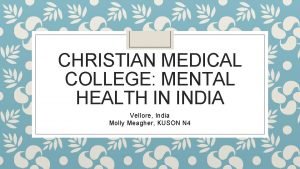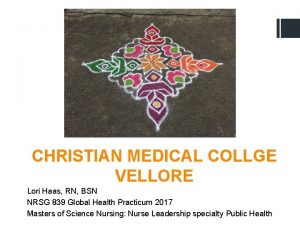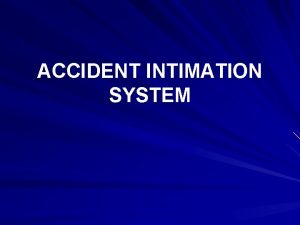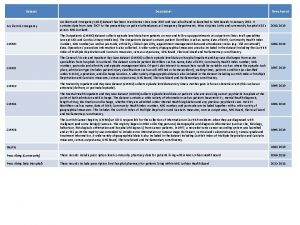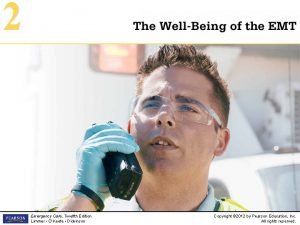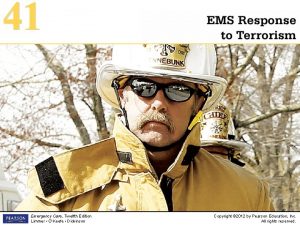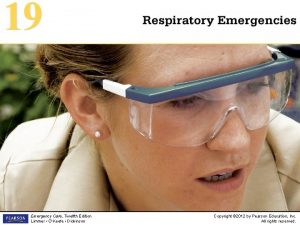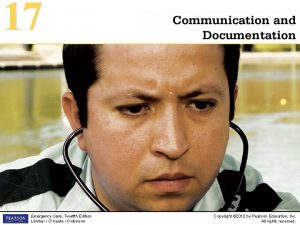Christian Medical College Accident Emergency Care in Vellore















- Slides: 15

Christian Medical College: Accident & Emergency Care in Vellore, India Elizabeth Lothamer, KUSON N 4

• Vellore, Tamil Nadu – India ▫ Population - 484, 690 (Census of India 2011) • Religious Breakdown of Vellore � 70% Hindu � 24% Muslim � 5% Christian �Less than 1% �Buddhist �Sikh �Jain �Other *Map of India with marker on Vellore

Background of Christian Medical College (CMC) • Founded by Ida S. Scudder ▫ An American Missionary • Est. 1900 – 1 bed clinic to serve women • 1902 – grew to 40 bed clinic to serve women and children • Present Day - over 2, 800 beds ▫ (4 x bigger than KU) *Ida S. Scudder, 1870 -1960 • Accredited by the National Accreditation Board for Hospitals (NABH) • Non-government, private, interdenominational Christian organization • Serves people from all over India

Accident & Emergency Department • 44 bed unit • 1 trauma bay (stable) • 3 open bays • Ratios ▫ Bay 1 -3: 10 beds � 2 nurses & 1 doctor ▫ For general emergencies ▫ Trauma Bay: 7 beds ▫ For all type one emergencies ▫ Unstable ▫ Resuscitation Room • 1 resuscitation room *Main entrance to emergency department � 1 nurse for 4 patients. 2 doctors � 5 -6 patients, 3 nurses, 2 doctors

Accident & Emergency Clinical Objectives • Identify the main causes for emergency room visits at CMC and compare to those seen at The University of Kansas Health System (TUKHS) • Identify the treatment process of the emergent patient at CMC • Discover the flow of patients and how the system functions under stress • Determine safety hazards in terms of patient care and the solutions that are being done to reduce them • Identify costs associated with care and it’s impact on clinical decision making *Crash cart located in the resuscitation room

Care of the Accident & Emergency Patient • Top 5 primary complaints ▫ ▫ ▫ Trauma (two-wheeler accidents, pedestrian vs. auto) Cardiac emergencies (HTN, CHF, rheumatic heart disease) Asthma & COPD exacerbations (pollution) Uncontrolled fever (typically GI or URI origin) Severe anemia • Treatment Process ▫ All patients are triaged upon arrival and receive an acuity rating �Level 1 – resuscitation room �First 4 hours of care free of charge for these patients �Level 2 – bay 1 through 3 �Level 3 – referred to outpatient clinic ▫ Emergency staff is conscious to the cost of care – utilize clinical diagnosis and then support with investigation to reduce cost �Average cost of care is 3, 000 rupees ($46 USD) – average income of CMC patient is 15, 000 rupees a month ($231 USD) �Additional costs incur for pharmaceuticals, diagnostic testing, radiographic imaging, and procedures performed

Care of the Accident & Emergency Patient • Flow of Patients ▫ 180 -200 pts/day � 100 -110 admitted ▫ Consider a stay greater than 12 hours in bays 1 through 3 over-stays �greater than 4 hours in the resuscitation room ▫ Bay average is 6 – 8 hours • Patient Safety and Delays of Care ▫ Limited Emergency Medical Services – ambulances are for transport, not for emergent stabilization or resuscitation (witnessed two DOAs) ▫ Infection control risk �Open units �Limited access for hand washing ▫ Limited Resources � 1 portable X-Ray, 1 ultrasound machine, 1 cat scanner. *Brought Dead Certificate �Paper charting – information uploaded to computers after patient is discharged �Discussion with family on cost of care – pick and choose what they can afford


Interventions and Strategies to Reduce Emergencies • Individual ▫ Increased access to primary care facilities �CONCH, CHAD, RHUSA ▫ Utilization of public health nursing for primary prevention and education in the villages �Fever management, clean drinking water education, dietary habit analysis, etc. ▫ Screenings provided in village clinics �HTN, anemia, diabetes, etc. • Community ▫ Emergency Department will teach first aid management and injury prevention to schools, colleges, factories, businesses, and more. �CPR, fracture stabilization, emergency preparedness, etc. ▫ Emergency medical services are very limited at the community level. Many patients self-present to the unit after trying home remedies.

Interventions and Strategies to Reduce Emergencies • System ▫ The World Health Organization (WHO) �Currently working with government organizations in India to improve road safety �Current laws are in place but they are not widely enforced �“The Global status report on road safety 2013 estimates that more than 231, 000 people are killed in road traffic crashes in India every year” (Kansla, 2017) �WHO hopes to accomplish: �Increased road traffic violation fines �More strict helmet laws ▫ Focus shift from communicable to non-communicable diseases �More government programs are being initiated to address the increase in non-communicable diseases like HTN, diabetes, etc.

*Family of 4 rides twowheeler *Blood pressure screening *Anemia screening *Busy morning commute

Conclusions & Suggestions • Conclusions ▫ A large problem in India is overpopulation �Creates concern when it comes to health care resources ▫ Must focus on primary prevention to ensure hospitals do not get over-run �When the Emergency Department starts to get over-ran the staff must rely on their team members and protocols in place in order to make things run smoothly • Suggestions ▫ The emergency department needs to expand in order to accommodate the mass intake the hospital experiences (44 unit beds for 2, 800 inpatient beds) ▫ Increased staffing in order to make safer nurse: patient ratios ▫ Updated equipment ▫ Quicker cost analysis and management in order to reduce care delays

Most Profound Clinical Experience • A double edged sword ▫ Staff maintains a diligent awareness to cost of care ▫ One patient on admittance was pronounced brain dead �The team decided not to intubate �Would not be a noble use of the family’s money �Discharged the patient to home to pass away with family ▫ Another patient on admittance had a skull fracture and was actively bleeding into his brain. �He had a 70% chance of making a livable recovery �Quality of life was unable to be determined. �Their was major delay in whether or not to perform surgery because of the discussion with family �After a significant amount of time had passed the family decided to pay for the surgery �Since it took hours to decide, the patients status had worsened and his odds of success were now worse ▫ I saw the consideration of cost be therapeutic for one patient and detrimental for another, creating a double edged sword phenomena

Most Profound Cultural Experience • The people *Girl from the village daycare ▫ I have never felt more welcomed in a foreign place ▫ I could not speak the language but through gestures, touch, and smiles I was able to connect with the people in a profound way ▫ Truly happy to invite us into their homes and wanted to share all they had ▫ The hospitality of Vellore, India is something of true *Woman from the village of beauty that I will forever Melminnal cherish

References Directorate of Census Operations Tamil Nadu (2011) Census of India 2011. District Census Handbook Vellore. 34, 1 -432. Retrieved from: http: //www. censusindia. gov. in/2011 census/dchb/3304_PART_B_D CHB_VELLORE. pdf Vellore Christian Medical College Foundation, Inc. (2017) Humble yet bold beginnings. Christian Medical College. Retrieved from: https: //www. vellorecmc. org/who-we-are/history/ World Health Organization (2017) Violence and injury prevention: road safety in India. World Health Organization. Retrieved from: http: //www. who. int/violence_injury_prevention/road_traffic/coun trywork/ind/en/
 Elizabeth kuson
Elizabeth kuson Sree krishna college of engineering vellore
Sree krishna college of engineering vellore C srinivasan waste management
C srinivasan waste management Gregory solomon vellore
Gregory solomon vellore Introduction to emergency medical care
Introduction to emergency medical care Introduction to emergency medical care
Introduction to emergency medical care Medical
Medical Introduction to emergency medical care
Introduction to emergency medical care Primary secondary tertiary medical care
Primary secondary tertiary medical care Emergency medical responder first on scene
Emergency medical responder first on scene American red cross first responder
American red cross first responder Chapter 31 assisting in a medical emergency
Chapter 31 assisting in a medical emergency Define medical emergency chapter 31
Define medical emergency chapter 31 Medical emergency student lectures
Medical emergency student lectures Emd guidecards
Emd guidecards Texas medicaid medical transportation program
Texas medicaid medical transportation program

